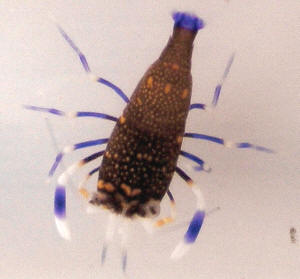|
FAQs about Harlequin
Shrimps Identification
Related FAQs: Gnathophylliids 1, Gnathophylliids 2, & FAQs on:
Gnathophylliid Behavior, Gnathophylliid Compatibility, Gnathophylliid Selection, Gnathophylliid Systems, Gnathophylliid Feeding, Gnathophylliid Disease, Gnathophylliid Reproduction, &
Marine
Shrimps 1, Marine Shrimps
3, Shrimp Identification,
Shrimp Selection, Shrimp Behavior, Shrimp Compatibility, Shrimp Systems, Shrimp Feeding, Shrimp Reproduction, Shrimp Disease, Cleaner
Shrimp, Banded Coral
Shrimp, Dancing Shrimp,
Harlequin Shrimp, Pistol Shrimp, Saron Shrimp, Mantis
Shrimp, Anemone
Eating Shrimp, Crustacean Identification, Crustacean Selection, Crustacean Behavior, Crustacean Compatibility, Crustacean Systems, Crustacean Feeding, Crustacean Disease, Crustacean Reproduction,
Related Articles: Harlequin Shrimp, Shrimp,
A Few Common Shrimps for the Marine Aquarium by James W.
Fatherree,
|

|
- Identifying the Hymenocera Shrimps - Hi, How are
the various species of harlequin shrimps identified? <Well... to my
knowledge, there are only two species: H. elegans and H. picta. Telling
them apart is reasonably easy as H. elegans almost always has some blue
in its colored spots, and sometimes the spots are entirely blue. Spots
on H. picta are typically a pink/salmon color with no blue at all.>
Someone has recently discovered some here in South Africa and is trying
to determine which of the harlequin shrimp species it is. Any ideas?
<Try the colors first.> Many thanks, James.
<Cheers, J -- >
| Shrimp ID help please -- 06/29/08
Hello WWM crew. Attached is a picture of a shrimp that I would like
some help verifying its ID, please. This shrimp was found by a
friend of mine while diving in Panama City, FL (northern Gulf of
Mexico). She found it when she picked up a long spine sea urchin to
show to a student (she is a dive instructor). She came to me and to
a biology teacher for help in identification. The biology teacher
thought it to possibly be in the Periclimenes family or possibly
the Gnathophyllum family. <The latter... though at first I too
thought it was a Palaemonid... faulty memory... more so all the
time> I did a lot of Google work and also searched your site but
found little info. Based on a few difficult to see photos, I
believe it is Gnathophyllum elegans. This seems supported (at least
down to the Gnathophyllum family) by the fact that it was found on
the bottom of an urchin, and Julian Sprung's book
"Invertebrates: A Quick Reference Guide" reports that
Gnathophyllum may feed on the feet of urchins and sea stars.
<Mmm, nah! Must> The best photos I could find with the full
scientific name came from not what I would consider highly reliable
sources and most of them were not written in English, but they were
the closest matches I could find and did indicate the scientific
name of Gnathophyllum elegans. Any help you could give towards a
definite ID would be greatly appreciated. Also, what are your
opinions as to their aquarium suitability (given that it would
almost certainly require a species only biotype). I realize their
natural diet would be difficult to replicate and not desirable to
replicate in my opinion. Mr. Sprung recommends feeding finely
chopped meaty foods and even flake foods; <No... like most of
its family, this animal feeds on the tube feet of certain
echinoderms found in its range. An interesting remark... it is
recorded as a facultative cleaner, removing parasites from fishes,
when young> however, I think he is somewhat overly optimistic on
some animals' aquarium suitability. Thanks for all your help
(past, present and future!). Sincerely, Rob Watson <Am almost
sure this is Gnathophyllum panamense... found from the lower Sea of
Cortez in Mexico's Baja to Ecuador... Bob Fenner> |
|

|
|
|

